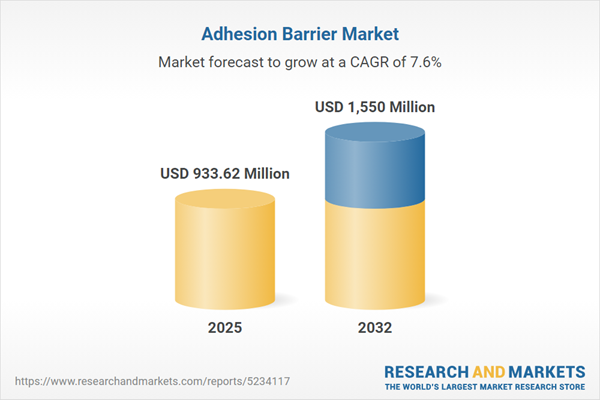Speak directly to the analyst to clarify any post sales queries you may have.
The adhesion barrier market is evolving swiftly, with healthcare organizations adopting innovative solutions to address patient care, regulatory compliance, and operational efficiency. Senior decision-makers are increasingly focusing on technologies that optimize clinical workflows, align with shifting standards, and deliver measurable value across healthcare networks.
Market Snapshot: Adhesion Barrier Market Trends and Growth
This market is witnessing robust compound annual growth rates and solidifying its presence within global healthcare systems. Driven by next-generation biomaterials and significant industry investment, the adoption of adhesion barrier products continues to rise. Key companies prioritize research and clinical customization, building technical expertise to maintain competitive standing. Industry dynamics are shaped by ongoing demand for operational improvements and a growing emphasis on value-based outcomes, supported by adherence to evolving regulatory frameworks. These developments are influencing both clinical methods and procurement decisions around the world, prompting healthcare providers to adapt procurement and technology strategies as the market landscape advances.
Scope & Segmentation of the Adhesion Barrier Market
- End Users: Ambulatory surgical centers turn to adhesion barrier solutions to efficiently manage large patient volumes, improving the consistency and efficiency of surgeries. Hospitals—spanning public and private sectors—adopt these products to sustain clinical compliance and maintain high standards of care. Fertility clinics and outpatient centers rely on adhesion barriers to deliver comprehensive care, supporting superior patient outcomes in a variety of clinical scenarios.
- Product Types: Films are designed to separate tissues and mitigate surgical complications. Gels provide necessary flexibility for minimally invasive procedures, supporting innovation in less invasive clinical practices. Powders offer rapid application for urgent cases, supplementing surgical performance and speed in time-sensitive situations.
- Applications: Cardiovascular surgeries employ adhesion barriers for risk reduction in challenging operative situations. General surgeons—including those performing laparoscopic procedures—use these solutions as part of standard and advanced protocols. Gynecological and orthopedic applications benefit from tailored product innovations that accelerate patient recovery.
- Regions: In the Americas, both the United States and Latin America display strong activity, with advanced procurement driving adoption. Europe shows widespread integration of new technologies across healthcare systems. Middle East and Africa experience growing uptake, while the Asia-Pacific region—especially China, India, Japan, Australia, and Southeast Asia—exhibits rapid expansion as infrastructure and regulations develop.
- Key Companies: Major players include Johnson & Johnson, Baxter International Inc., Sanofi S.A., Medtronic plc, Integra LifeSciences Holdings Corporation, B. Braun Melsungen AG, Covalon Technologies Ltd., Kaken Pharmaceutical Co., Ltd., FzioMed Inc., and Confluent Surgical, Inc. These organizations distinguish themselves through specialized solutions, research leadership, and adaptation to healthcare trends.
Key Takeaways for Senior Decision-Makers
- Adhesion barriers support safer surgical environments by reducing post-operative complications and optimizing recovery times across multiple specialties.
- The adoption of bioresorbable films and hydrogels facilitates smooth integration with evolving clinical protocols, meeting the needs of both specialized and general surgical teams.
- Adapting to dynamic regulatory and reimbursement environments requires robust, compliant supply chains and flexible supplier partnerships.
- Procurement strategies increasingly factor in the ability of products to integrate with digital platforms and analytics, enhancing oversight and measurable outcomes.
- Segmenting procurement by product and application enables precise alignment with procedural requirements, delivering efficiency in clinical implementation.
- Awareness of regional regulatory and clinical distinctions is vital for successful international growth and sustainable market participation.
Tariff Impact on Supply Chain and Production
Recent tariff adjustments in the U.S. have raised core production costs for materials such as polymers and hydrogels within the adhesion barrier market. In response, manufacturers are diversifying supplier networks, increasing local sourcing, and optimizing inventory. These strategies help maintain operational stability, manage supply chain risks, and enable ongoing procurement regardless of shifting regulatory demands.
Methodology & Data Sources
This report draws on structured interviews with senior surgeons, procurement professionals, and supply chain leaders. The research is complemented by analysis of published medical literature, regulatory assessments, and review of procedural and trade data, resulting in actionable insights for executive decision-makers.
Why This Report Matters
- Enables procurement and sourcing executives to align supplier selection with evolving clinical and institutional objectives for more effective resource planning.
- Offers targeted guidance to help organizations manage supply chain complexities and tariff impacts, supporting resilience in a changing marketplace.
- Improves decision-making by applying best practices in segmentation and adoption of new technologies across diverse market environments.
Conclusion
Healthcare organizations that utilize this intelligence can drive compliance, maintain flexibility, and achieve sustainable outcomes in the rapidly advancing adhesion barrier market.
Additional Product Information:
- Purchase of this report includes 1 year online access with quarterly updates.
- This report can be updated on request. Please contact our Customer Experience team using the Ask a Question widget on our website.
Table of Contents
3. Executive Summary
4. Market Overview
7. Cumulative Impact of Artificial Intelligence 2025
Companies Mentioned
The companies profiled in this Adhesion Barrier market report include:- Johnson & Johnson
- Baxter International Inc.
- Sanofi S.A.
- Medtronic plc
- Integra LifeSciences Holdings Corporation
- B. Braun Melsungen AG
- Covalon Technologies Ltd.
- Kaken Pharmaceutical Co., Ltd.
- FzioMed Inc.
- Confluent Surgical, Inc.
Table Information
| Report Attribute | Details |
|---|---|
| No. of Pages | 186 |
| Published | October 2025 |
| Forecast Period | 2025 - 2032 |
| Estimated Market Value ( USD | $ 933.62 Million |
| Forecasted Market Value ( USD | $ 1550 Million |
| Compound Annual Growth Rate | 7.5% |
| Regions Covered | Global |
| No. of Companies Mentioned | 11 |









